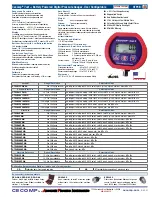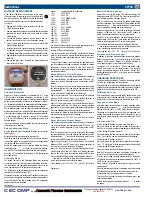
Instructions CTP3B
Sensor
Suggested units for calibration
3 PSI
6.920 FTH2O
5 PSI
5.000 PSI
15 PSI
775.7 MMHG or TORR
30 PSI
61.08 INHG
50 PSI
50.00 PSI
60 PSI
60.00 PSI
100 PSI
7.031 KG/CM2
200 PSI
407.2 INHG
300 PSI
610.8 INHG
500 PSI
3447 KPA
1000 PSI
6895 KPA
2000 PSI
4614 FTH2O
3000 PSI
6920 FTH2O
5000 PSI
5000 PSI
The display will then indicate the currently applied pressure in
the engineering units selected for calibration.
s
and
t
Button Operation
Each time one of the
s
or
t
buttons is pressed and released
quickly, a small change is made to the digitized pressure signal.
It may take more than one button press to make a change on
the display.
To make larger changes, press and hold the appropriate but-
ton. After about one second, the display will begin to change
continuously. Release the button to stop. Then make fine
adjustments by pressing and quickly releasing the buttons as
previously described.
Gauge Reference Pressure Gauges
Apply zero pressure by venting the gauge port to atmosphere.
The character display will alternate between ZERO and CAL.
Adjust for a display indication of zero using the
s
and
t
buttons.
Note: At this point you may re-zero the gauge without doing
any other calibration. Press and hold the Power button until the
display indicates - - - - then release the button to store the new
zero in non-volatile memory and restart the gauge.
Apply full-scale pressure. The character display will alternate
bSPAN and CAL. Adjust for a display indication of
full-scale pressure using the
s
and
t
buttons.
Apply 50% full-scale pressure. The character display will alter-
nate bMID and CAL. Adjust for a display indication
equal to 50% of full-scale pressure using the
s
and
t
buttons.
Press and hold the Power button until the display indicates - - - -
then release the button to store the calibration parameters in
non-volatile memory and restart the gauge.
Verify readings at 0%, 25%, 50%, 75% and 100% of full scale.
Gauge Reference Vacuum Gauges
Apply zero pressure by venting the gauge port to atmosphere.
The character display will alternate between ZERO and CAL.
Adjust for a display indication of zero using the
s
and
t
buttons.
Note: At this point you may re-zero the gauge without doing
any other calibration. Press and hold the Power button until the
display indicates - - - - then release the button to store the new
zero in non-volatile memory and restart the gauge.
Apply full-scale vacuum. The character display will alternate
bSPAN and CAL. Adjust for a display indication of
full-scale vacuum using the
s
and
t
buttons.
Apply 50% full-scale vacuum. The character display will alter-
nate bMID and CAL. Adjust for a display indication
equal to 50% of full-scale vacuum using the
s
and
t
buttons.
Press and hold the Power button until the display indicates - -
- - then release the button to store the calibration parameters
in non-volatile memory and restart the gauge.
Verify readings at 0%, 25%, 50%, 75% and 100% of full scale.
Continued >>
cecomp.com
1220 American Way Libertyville, IL 60048
800-942-0315
CECOMP
Div. of
A
A
BSOLUTE
BSOLUTE
P
P
ROCESS
ROCESS
I
I
NSTRUMENTS
NSTRUMENTS
CALIBRATION
Setup and Preparation
Gauges are factory calibrated at approximately 23°C using
NIST traceable calibration equipment. Calibration is not
required before using the gauge. Calibration intervals depend
on your quality standards, but annual re-calibration is custom-
ary. Calibration should only be performed by qualified individu-
als using appropriate calibration standards and procedures.
The calibration system must be able to generate and measure
pressure/vacuum over the full range of the gauge and should be
at least four times more accurate than the gauge being calibrated.
A vacuum pump able to produce a vacuum of 100 microns
(0.1 torr or 100 millitorr) or lower is required for vacuum and
absolute gauges.
Install fresh batteries. Allow the gauge to acclimate to ambient
temperature for 20 minutes.
Entering Calibration Mode
With the gauge off, press and hold the
t
button, then press the
Power button.
Release all buttons when the display indicates CAL.
The display begins by indicating the full-scale positive pressure
rating of the gauge in the engineering units as configured by
the factory, and then shows all display.
Before the gauge enters the Calibration Mode, the display
initially indicates _ _ _ _ with the first underscore blinking,
and with CALPC (calibration passcode) on the lower display.
Enter the 3510 passcode as described in the Configuration
Passcode section.
Calibration Mode
The gauge remains in the Calibration Mode until restarted
manually or power is removed. Features not related to calibra-
tion are disabled and compound range models are set for the
same engineering units for pressure and for vacuum.
The calibration may be performed in any of the available engi-
neering units as well as percent (PCT).
For greatest accuracy, use the
s
and
t
buttons to select engi-
neering units for calibration with highest number of display counts.
Press and release the Power button when the appropriate
engineering units are displayed.
Continued >>
Absolute Reference Gauges
Apply full vacuum to the gauge. The character display will
alternate between
ZERO
and
CAL
. Press the
s
and
t
but-
tons to obtain a display indication of zero.
Note: At this point you may re-zero the gauge without doing
any other calibration. Press and hold the Power button until the
display indicates - - - - then release the button to store the new
zero in non-volatile memory and restart the gauge.
Apply full-scale pressure. The character display will alternate
bSPAN and CAL. Press the
s
and
t
buttons to
obtain a display indication equal to full-scale pressure.
Apply 50% of full-scale pressure. The lower display will alter-
nate bMID and CAL. Press the
s
and
t
buttons to
obtain an indication equal to 50% of full-scale pressure.
Press and hold the Power button until the display indicates - -
- - then release the button to store the calibration parameters
in non-volatile memory and restart the gauge.
Verify readings at 0%, 25%, 50%, 75% and 100% of full scale.
Compound and Bipolar Gauges
In addition to the steps described above for pressure gauges,
apply full-scale vacuum. The character display will alternate
between -SPAN and CAL. Adjust for a display indication of
actual applied vacuum using the
s
and
t
buttons.
For bipolar and –30.00inHg to 15.00psi compound range
models only, apply 50% full-scale vacuum. The character
display will alternate between -MID and CAL. Adjust for a
display indication equal to 50% of full-scale vacuum using the
s
and
t
buttons.
CHANGING PASSCODES
The factory default passcode 3510 may be changed to a differ-
ent value for configuration and/or calibration.
With the gauge off, press and hold the
s
button to view and/or
change the user configuration passcode. Then press the Power
button. Release all buttons when the display indicates CFG.
Calibration Passcode
With the gauge off, press and hold the
t
button to view and/
or change the user calibration passcode. Then press the Power
button. Release all buttons when the display indicates CAL.
Change Passcode Mode
Before the gauge enters the view or change passcode mode,
the display initially indicates _ _ _ _ with the first underscore
blinking, and with CFGPC or CALPC on the character display.
The gauge will automatically revert to normal operation if no
buttons are operated for approximately 15 seconds. To cancel
and return to normal operation, press and release the Power
button.
Enter access code 1220:
Use the
s
and
t
buttons to set the left-most digit to 1.
Press and release the Power button to index to the next posi-
tion. The 1 will remain, and the second position will be blinking.
Use the
s
and
t
buttons to select 2.
Press and release the Power button to index to the next posi-
tion. 1 2 will remain, and the third position will be blinking.
Use the
s
and
t
buttons to select 2.
Press and release the Power button to index to the next posi-
tion. 1 2 2 will remain, and the fourth position will be blinking.
Use the
s
and
t
buttons to select 0.
Press and release the Power button to proceed.
Note: If an incorrect access code was entered, the gauge will
return to the start of the access code entry sequence.
Once the access code has been entered correctly, the display
will indicate the existing user-defined passcode with CFGPC or
CALPC on the character display.
Press the
s
or
t
button to select the first character of the
new passcode.
When the desired first character is displayed, press and release
the Power button to proceed to the next passcode character.
Repeat above until the entire passcode is complete.
To exit the User Defined Passcode change mode, press and
hold the Power button.
Release the button when the display indicates - - - - to restart
the gauge.
BATTERY REPLACEMENT
A low battery indication will be shown in the upper
left-hand corner of the display when the battery volt-
age falls sufficiently. The batteries should be replaced
soon after the indicator comes on or unreliable readings
may result.
1. Remove the 6 Phillips screws on the back of the unit.
2. Lift up the battery holder.
3. Remove batteries by lifting up the positive end of the battery
(opposite the spring) taking care not to bend the battery
holder spring.
4. Discard old batteries properly, do not discard into fire,
sources of extreme heat, or in any hazardous manner.
5. Always replace both batteries at the same time with high
quality alkaline batteries.
6. Install batteries with correct orientation. Incorrect polarity
will damage the gauge. The negative (flat) end of each bat-
tery should be inserted first facing the battery holder spring.
7. Replace battery holder face down being careful not to pinch
the wires.
8. Replace the back cover, including the rubber gasket and
reinstall the six screws.
Lift up the
battery holder




